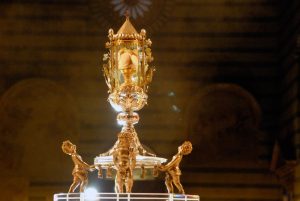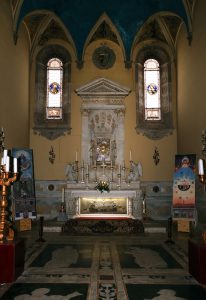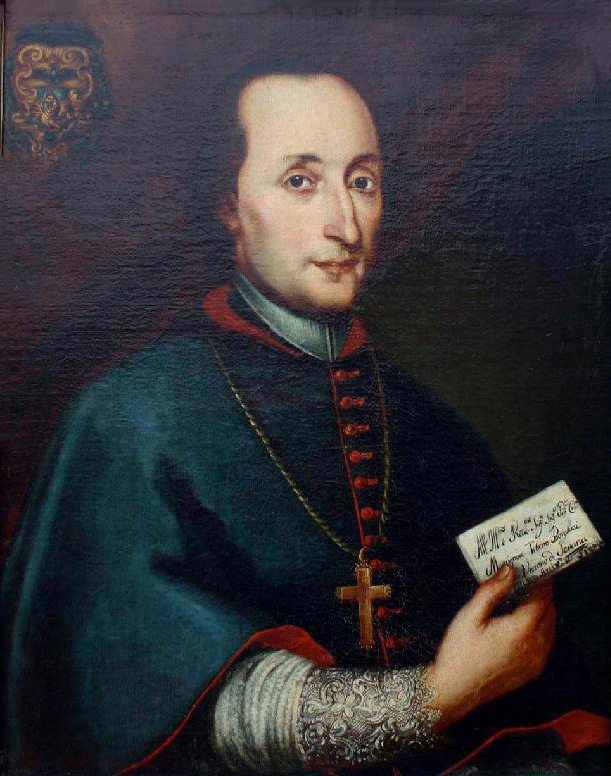8.2 Via Panis
HISTORY
The Basilica of San Francesco is one of the most important places of worship in the city. For almost three hundred years, it has been the guardian and witness of what the Catholic Church defines as a perpetual Eucharistic miracle, that is, a prodigious and ongoing event involving the Eucharist.
On the evening of 14 August 1730, the Frati Minori Conventuali di San Francesco (Order of Friars Minor Conventual of Saint Francis) placed a silver pyx with 351 consecrated particles inside the tabernacle of one of the basilica’s chapels—the one dedicated to Saint Anthony—and then, as they do every year, they closed the church door and went to the cathedral, together with the entire population of Siena, for the celebration of Vespers on the eve of the Feast of Our Lady of the Assumption. The next day, during the celebration of the Eucharist, a terrible misdeed was discovered: the pyx containing the particle had been stolen. News of the sacrilegious act spread throughout the city and that day, which had always been characterised by great joy for the feast of the Assumption, was marked by such profound dismay that the decision was even taken not to run the Palio on 16 August.
The civil and religious authorities immediately launched a search until a cleric in the nearby collegiate church of Santa Maria in Provenzano happened to catch a glimpse of something white inside the alms box during mass on 17 August. He reported it to the sexton and called Archbishop Alessandro Zondadari and the vicar-general to come. Once the particles had been examined and identified as those that had been stolen, the city was freed from its burden and the entire population flocked to pay homage. A solemn procession was organised and, in a blaze of song and prayer, accompanied by a huge crowd, the particles were brought back to San Francesco, where the question of what to do with them arose. The friars did not want to destroy them because they had been consecrated and thus contained the Divine Presence, but neither could they use them because they had been sitting for days in a dirty box, amidst money and dust. It was finally decided to let nature take its course and wait for them to deteriorate on their own. Almost three centuries have passed since that time and those particles, against all laws of chemistry and biology, are still miraculously intact.
VERIFICATION
Displayed for the adoration of the faithful following their recovery, the particles were then ‘forgotten’, until, fifty years after their discovery, it became apparent that there was something abnormal about them: contrary to what one might have expected, they showed no sign of decay and looked as if they had just been made.  An experiment, the first of a series over the centuries, was performed on the particles in an attempt to understand how it was possible that organic material, which by its very nature is destined to spoil, could remain in a perfect state of preservation. Thus, during a canonical visit in April 1780, the Minister General of the Franciscans, Father Giovanni Carlo Vipera, found the small particles wrapped in a corporal inside a wooden box and had them placed in a silver chalice, counting 230 from the original 351. After an examination carried out by him, he wrote these words: ‘We have recognised as a sort of true miracle the fact that they have been preserved unchanged for the very long period of fifty years’. The bishop at the time, Tiberio Borghesi, also ordered a counter-test: he had some unconsecrated particles closed in a sealed tin box for ten years. When they were reopened, the scientific commission in charge found only maggots and putrefying fragments.
An experiment, the first of a series over the centuries, was performed on the particles in an attempt to understand how it was possible that organic material, which by its very nature is destined to spoil, could remain in a perfect state of preservation. Thus, during a canonical visit in April 1780, the Minister General of the Franciscans, Father Giovanni Carlo Vipera, found the small particles wrapped in a corporal inside a wooden box and had them placed in a silver chalice, counting 230 from the original 351. After an examination carried out by him, he wrote these words: ‘We have recognised as a sort of true miracle the fact that they have been preserved unchanged for the very long period of fifty years’. The bishop at the time, Tiberio Borghesi, also ordered a counter-test: he had some unconsecrated particles closed in a sealed tin box for ten years. When they were reopened, the scientific commission in charge found only maggots and putrefying fragments.
Several times over the decades, illustrious men have examined the particles by every means available to them, while at the same time exposing them to factors and elements that should have favoured their decay, such as decanting, handling, dust, and humidity. Despite this, surveys have always yielded the same result: they remain intact, without any signs of deterioration. The first scientific inspection, authorised in 1914 by Pope St Pius X, was carried out with the participation of eminent professors of bromatology, hygiene, chemistry, and pharmaceutics. One of them, Siro Grimaldi of the University of Siena, wrote that after 184 years the particles were still ‘shiny and smooth, with clean edges, not frayed or blunted. Free of mites, woodworms, cobwebs, mould, and all other animal and vegetable parasites of the wheat flour from which they are made’. The specialist explained that wheat flour is extremely susceptible to spoilage, providing an ideal breeding ground for micro-organisms of all kinds. The commission’s final verdict concluded that the sacred particles ‘constitute a singular phenomenon, palpitating with actuality, which reverses the natural laws of the conservation of organic matter. It is a unique fact consecrated in the annals of science’.
In the first half of the last century, the particles were handled extensively: Cardinal Giovanni Tacci transferred them to a cylinder made of pure rock crystal in 1922; in 1950, they were placed in a more precious monstrance, while in 1951, during another sacrilegious episode, thieves, in an attempt to steal the monstrance, broke its seals and threw the particles into a corner of the marble surface of the tabernacle.
The latest examination was carried out in 2014 at the behest of Archbishop Antonio Buoncristiani, a century after the first scientific analyses and during the Year of the Eucharist, as proclaimed by Buoncristiani himself. Samples of the particles (now 255 in number) were examined and the crystal cylinder, which was last cleaned in 1952 following the sacrilegious theft of the monstrance, was cleaned. The particles, which were clearly in an excellent state of preservation, were subjected to various tests, including surface inspection, culture tests, and close-up photogrammetry. Prior to cleaning, all surfaces of the crystal container were also analysed using sterile swabs.
The results confirmed the good state of preservation of the sacred objects and the total absence of contamination. The culture test did not reveal any microbial growth. The particles therefore continue to be prodigiously uncorrupted, a clear sign that strengthens the faith of the People of God in the Eucharist, the summit and source of the Church’s entire life, the sacrament of unity and bond of charity among Christians.
DEVOTION
Today, the sacred particles are housed in the Piccolomini Chapel during the summer months and in the Martinozzi Chapel during the winter months. In almost three hundred years of history, they have been the object of theft, abandoned in a wooden box for nearly fifty years, and transferred to different containers, all of which has been compounded by two interminable renovations of the sacred building and by political and wartime events such as the Napoleonic invasion and the Unification of Italy, which saw the transformation of the convent and the Basilica of San Francesco, which passed from the Franciscans into different hands, later becoming the seat of the Seminary of Siena. It is truly an extraordinary miracle that was only revealed to the world in 1914, with the first scientific analysis of the particles. Since then, the particles have been at the centre of a devotion that continues to be nourished today by a variety of initiatives: the homage of the Contradas, the homage of the children at their First Communion, the solemn procession on the Feast of Corpus Christi, the Eucharistic Septenary at the end of September, and the Eucharistic Day on the 17th of each month in memory of their discovery on 17 August 1730.

credit Sailko
Venerated by the faithful, the sacred particles were also adored by His Holiness John Paul II during his pastoral visit to Siena on 14 September 1980. On that occasion, after having heard their story, he was moved to tears and exclaimed: ‘It is the Presence!’ The city’s perpetual Eucharistic miracle, for which time has stood still, offers everyone—from the most sceptical to the most distracted—the chance to see with their own eyes and touch with their own hands one of Christ’s greatest wonders on earth, before which even science has bowed its head. The great scientist Enrico Medi said: ‘This direct intervention of God is a miracle [. . .] a miracle in the strict sense of the word, miraculously accomplished and maintained for centuries, testifying to the permanent reality of Christ in the Eucharistic Sacrament. In these times, so difficult for Christianity and for the Church, in which false doctrines resurface that would like to undermine our faith, the city of Siena raises its banner and presents its miracle to the world’.
Particle: a thin disc of unleavened bread made from wheat flour and water. Once consecrated by the priest, it is considered the Body of Christ and is offered to the faithful during the Eucharistic celebration. The host is a larger particle raised by the priest during the consecration.
Pyx: a sacred cup-shaped vessel with a lid, used to hold the particles consecrated for the Eucharist. Usually made of precious metal and always gilded inside.
Tabernacle: a small closed aedicule where the hosts and consecrated particles are kept.
Monstrance: a sacred object whose function is to display the consecrated host, the Body of Christ, to the adoration of the faithful.
Corporal: a square-shaped cloth used during the celebration of Mass, first folded to cover the chalice, then laid on the altar to hold the paten—a sort of small circular dish—containing the host and the chalice with the wine, respectively the Body and Blood of Christ.
